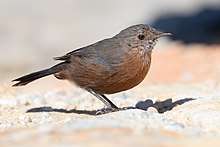Rockwarbler
The rockwarbler (Origma solitaria), is a bird in the family Acanthizidae. It is the only bird species endemic to the state of New South Wales in Australia.
| Rockwarbler | |
|---|---|
 | |
| Scientific classification | |
| Kingdom: | Animalia |
| Phylum: | Chordata |
| Class: | Aves |
| Order: | Passeriformes |
| Family: | Acanthizidae |
| Genus: | Origma |
| Species: | O. solitaria |
| Binomial name | |
| Origma solitaria (Lewin, 1808) | |
| Synonyms[2] | |
|
Sylvia solitaria, Lewin | |
English artist and naturalist John Lewin described the rockwarbler in 1808.[2] For many years it was the only member of its genus until genetic work showed that it was related to two species of mousewarblers from New Guinea. The rockwarbler diverged from the common ancestor of the other two species around 9 million years ago.[3][4] Rockwarbler has been designated the official name by the International Ornithologists' Union (IOC).[5] Common names also include cataract-bird, cave-bird, origma, rock-robin, and sandstone robin.[2] A former common name, hanging dick, came about from its nest, which hangs suspended in a cave.[6]
The rockwarbler is 14 cm (5.5 in) in length and weighs around 14 g (0.49 oz), with predominantly dark grey-brown plumage, darker wings and more red-brown underparts, cinnamon-tinged face and forehead, and whitish throat. Its tail is black.[7]
It is usually seen hopping erratically over rocks while flicking its tail. Its preferred habitat is woodland and gullies with exposed sandstone or limestone rocks, and often near water. Its distribution is central eastern New South Wales, within a 240 km (150 mi) radius of Sydney. It has been affected adversely by human-modified habitat, and has declined in these areas.[7]
Mated pairs maintain a territory, nesting in a sandstone cave.[7] The nest is a hanging structure made of grasses, roots, bark and moss, with spider web used as an adhesive. It has a dome-shaped entrance. Breeding season is from August to January, the female laying a clutch of three eggs, which take around 23 days to hatch.[7]
References
- BirdLife International (2012). "Origma solitaria". IUCN Red List of Threatened Species. 2012. Retrieved 26 November 2013.CS1 maint: ref=harv (link)
- Australian Biological Resources Study (5 December 2014). "Species Origma solitaria (Lewin, 1808)". Australian Faunal Directory. Department of the Environment, Water, Heritage and the Arts, Australian Government. Retrieved 5 June 2019.
- Norman, J.A.; Christidis, L.; Schodde, R. (2018). "Ecological and evolutionary diversification in the Australo-Papuan scrubwrens (Sericornis) and mouse-warblers (Crateroscelis), with a revision of the subfamily Sericornithinae (Aves: Passeriformes: Acanthizidae)". Organisms Diversity & Evolution. 18 (2): 241–259. doi:10.1007/s13127-018-0364-8.
- Gill, Frank; Donsker, David, eds. (2019). "Bristlebirds, pardalotes, Australasian warblers". World Bird List Version 9.1. International Ornithologists' Union. Retrieved 21 January 2019.
- Gill, Frank; Donsker, David, eds. (2017). "Bristlebirds, pardalotes, Australasian warblers". World Bird List Version 9.1. International Ornithologists' Union. Retrieved 6 June 2019.
- "Rockwarbler". Birdlife Australia. Retrieved 7 June 2019.
- "Rockwarbler". Birds in Backyards. Birdlife Australia. Retrieved 5 June 2019.
- del Hoyo, J.; Elliot, A. & Christie D. (editors). (2006). Handbook of the Birds of the World. Volume 12: Picathartes to Tits and Chickadees. Lynx Edicions. ISBN 978-84-96553-42-2
